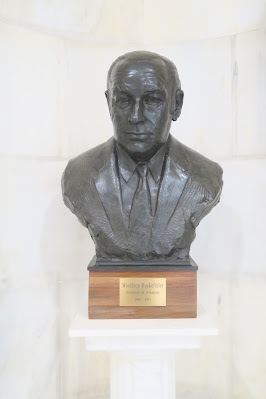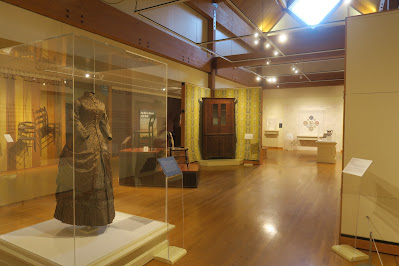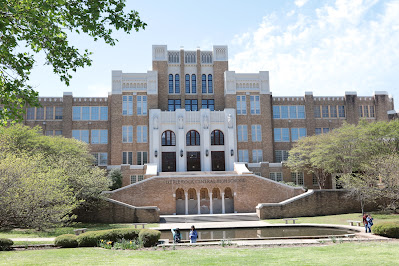This is my third post about our family's visit to Arkansas, Oklahoma, and Texas. I suggest starting with the first and second posts. Because I blog about educational travel, some of the places we visited gave me admission tickets, discounts, media rates, and other benefits. Some locations we toured are free for everyone; we paid full price for the rest. That has no bearing on my reviews. Everything I'm sharing is something that I recommend without hesitation. If you see any gaps in my narrative, it is because I didn't love that particular attraction, hotel, or restaurant enough to recommend it to you, regardless of how much I paid or didn't pay.
---------
Little Rock, Arkansas
We got up early on Saturday, April 8 and headed to Historic Arkansas Museum.
My favorite exhibit was the "We Walk In Two Worlds: The Caddo, Osage, and Quapaw People of Arkansas Native American Gallery."
Unfortunately, the Knife Gallery is currently closed for refurbishment. Until recently, I would have walked right past a gallery of knives with barely a glance, but last summer we binge-watched all the episodes of Forged in Fire. Historic Arkansas Museum houses the official exhibit for the American Bladesmith Society and the ABS Hall of Fame. Now that I understand how they are made and the skill involved, I would have loved to see these knives, many of which feature precious metals and gemstones to highlight their intricate designs.
The hands-on Sturgis Children's Gallery lets kids interact with all the things they'll find in the outdoor portion of the museum. The puppet theater, the bellows, 19th century dress-up clothes, and the plush vegetables in the mini garden look like a lot of fun for young visitors.
The outdoor portion of the HAM preserves a historic city block, including Hinderliter Grog Shop, built in 1827. It is the oldest building in Little Rock. The 1850's farmstead is home to a Living History program that looks great. Unfortunately, it opens later than the museum galleries and we weren't able to experience it. This is as much of the outdoors that we saw.

Our next stop was the Arkansas State Capitol.
Don't miss Arkansas' Liberty Bell replica. It's housed outdoors in a covered pavilion. Topeka, take a lesson from Little Rock. This is how you display a bell.
Right next to the bell is this monument to the Little Rock Nine. You can read all about it, and the many other monuments on the Capitol grounds, in this handy self-guided tour booklet. Great job, Arkansas!
When we visited, the Arkansas flag was flying at half-staff as tribute to the memory of Senator Roy C. “Bill” Lewellen.
The inside of the Capitol was really nice. Having visited 30+ Capitol buildings, some of them blend together in my memory, but this was one of the prettier ones.
It's also the only one where I can remember seeing every state flag displayed indoors. They were all displayed outdoors in Montgomery.
I don't remember seeing a photo of the state's beauty queen displayed prominently in the Capitol before.
Arkansas really likes their State Seal. It's everywhere.

As expected, many of Arkansas' governors are featured in the Capitol. I'm choosing not to post the photo of the guy who preferred to shut down the entire school district for a year rather than allow racial integration. He's been called both the "best loved" and "most hated" of Arkansas politicians. As someone who greatly values both education and racial equality, you can guess where I stand.
I can't actually name a lot of Arkansas politicians, but here are two I recognized. I learned all about Winthrop Rockefeller on the outstanding We Didn't Start the Fire podcast. (Hilariously, during the episode with Billy Joel himself, we learned that was the wrong Rockefeller.) That's a young Bill Clinton on the right.


The Capitol had some really cool displays. I loved this one about Arkansas stamps. (I love stamps.)
We all enjoyed learning about Arkansas' state symbols. Steve is looking at a dutch oven, their State Cooking Vessel.
Trevor recognized a work by Audubon (he recently did a report on him) and I was fascinated by Arkansas' changing state nicknames. It's earliest nicknames were "Bear State" and "Toothpick State" (an Arkansas toothpick being a knife like the murder weapon I learned about at the Old State House). In 1923, Arkansas named itself "The Wonder State" then changed to "Land of Opportunity" in 1953. In 1995, Arkansas adopted its current nickname, "The Natural State."


We had lunch at The Root Cafe, featured on Diners, Drive-Ins, and Dives.
The cafe is fun and funky. We sat in the part of the dining room made from upcycled shipping containers.
The food is sourced from small farms in Arkansas. When you order, the table tag they give you isn't a number. It's a biography of one of their farms. Ours was KirbyMel Farms.
The food was outstanding. Definitely go.
I don't remember learning about the Little Rock Nine in high school (sadly, if I did, it was probably a single paragraph in a textbook), but I vividly remember learning about the attempted integration of Little Rock Central High School when I was in college. It left a strong impression on me. But it wasn't until I became a teacher, with a room of 32 students with all different skin colors, that I felt the injustice so personally.
I've wanted to visit Little Rock Central High School ever since. It's hard to explain the emotions I felt when I was finally there - a strange mix of joy and grief.
We started out at the Visitor Center, which gives an excellent overview of the 1957 Crisis at Central High.
Then we took a ranger-led tour. Ranger Rebecca Hoffman is one of the best tour guides I have ever had, anywhere, in my 50 years of traveling. Her knowledge about the Civil Rights Movement and passion for racial equality is impressive and her storytelling abilities are outstanding. She unapologetically shared facts that others might have softened or glossed over. I am so glad to have experienced Little Rock Central High School with her.
Ranger Rebecca started with a classroom presentation, then walked us to the high school. Along the way, she showed us the path that 15-year old Elizabeth Eckford took, alone, as she was confronted by an angry white mob.
We learned where she tried to enter the school, from multiple entrances....
... before finally walking to a bus stop at the end of the block in a desperate attempt to get home. She describes her experience in verse in her illustrated autobiography, The Worst First Day (affiliate link).
Little Rock Central High School is still an operating high school. We were visiting on a Saturday, so there were no students there. The public can't go into the building, regardless of whether it's a weekend or a weekend, but there's plenty to see from the outside. Each of the Little Rock Nine has a bench surrounding the school's reflecting pool.
A fellow tourist took our picture, the only photo we have of all three of us together from the whole trip.
We walked back to the Visitor Center via the Commemorative Garden...
... then made a stop at the Magnolia Mobile Gas Station, which became the de facto media center during the Crisis.
The visit to Little Rock Central High School was one of the highlights of the trip for me. I am so glad we were finally able to visit.
Our next stop was the Mosaic Templars Cultural Center. The museum serves to preserve and celebrate African American history and culture in Arkansas.
The Center gets its name from the Mosaic Templars of America, which was a Black fraternal organization founded in 1883 in Little Rock.
"At first glance, it may seem strange to see an empty case. Exhibits are designed to be filled. At times, the emptiness of space can speak just as loud or even louder than the objects that are missing.Racial terror was an everyday and normal occurrence in the lives of African Americans in the state of Arkansas. Objects of racial oppression that were symbols of hate will not be displayed in this case. Instead, [this] exhibition case is a signifier to honor the power of the seen and unseen. This space is held to honor the lives that were lost, the families that were impacted and the legacy that remains."
They have a very nice children's area, with lots of multicultural and inclusive play spaces.
After another long day, we returned to the DoubleTree for our third and final night in Little Rock. I took a photo of a large sign in the lobby, then edited it to highlight everything we did during our time in town. As you can see, we did pretty well, visiting about half of Little Rock's attractions. I wish we'd had time to do more, but that just means there's fresh stuff to see the next time we visit.


Our next destination was to the southwest. As we drove, we saw a critter that I never would have guessed I'd see in Arkansas! I'd never actually seen one in real life. On Monday, I'll tell you all about it and everything else we saw. If you can't wait, here's a little hint, in the form of an affiliate link.















































No comments:
Post a Comment
I moderate comments, so you will not see yours appear right away. Please check back if you had a question; I promise to answer it as soon as I see it. Thank you for taking the time to comment!